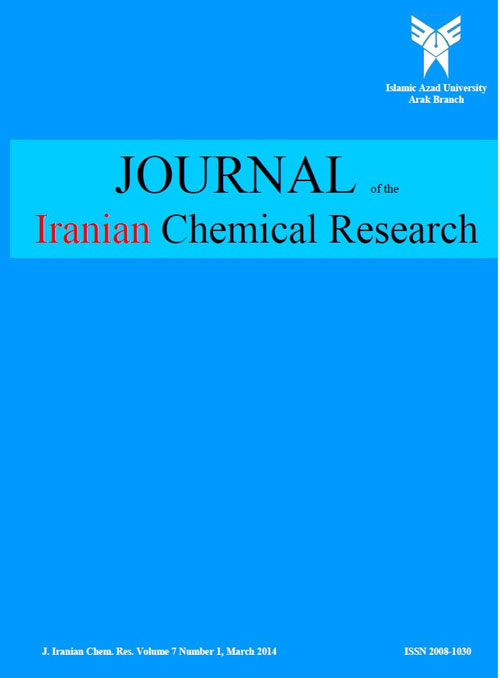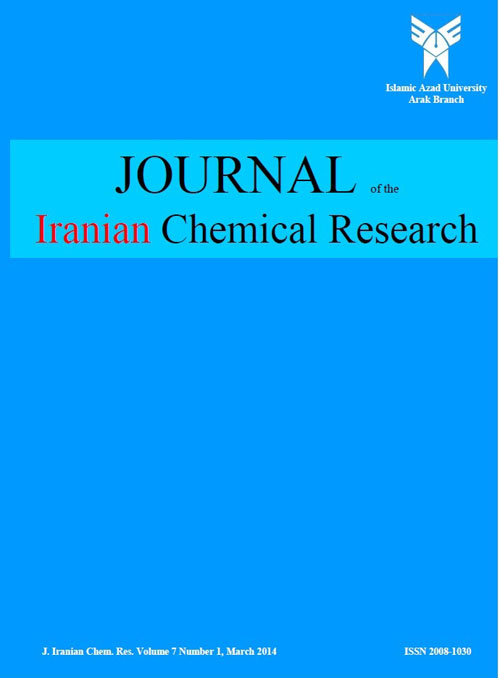فهرست مطالب

Journal of the Iranian Chemical Research
Volume:2 Issue: 4, Autumn 2009
- تاریخ انتشار: 1388/09/30
- تعداد عناوین: 8
-
Preparation and molecular weight determination of soya-beans and benniseed oil-modified alkyd resinsPages 231-238Alkyd resins were prepared into four different sets by varying the percentage concentration of the glycerol content. Various properties such as the viscosity, Surface drying time, solubility and color of the alkyd resins were evaluated for the various sets. The alkyd resin with the highest glycerol content was the most viscous, brownish in color and having the highest molecular weight this is due to the ratio 1:3 oil to glycerol content.Keywords: Soybean oil, Benni, seed oil, Alkyd, Resin
-
Pages 239-241One series of half-analogues of Michlers ketone containing one or more terminal methoxy substituents with variable tertiary amino groups have been used in this study. NMR spectral results for the parent ketones confirm earlier findings that ortho proton shifts are apparently independent from steric effects in derivatives of Michlers ketone because the ring current and carbonyl-induced shifts are self-canceling.Keywords: Conformational study, Michler's Ketone, NMR Spectroscopy, Proton Shift, Steric Effect, Ring Current, Carbonyl, induced shift, Tertiary amino groups
-
Pages 243-246Silica sulfuric acid is employed as solid acid catalyst for the clean and less hazardous protection of carbonyl compounds as 2,4-dinitrophenylhydrazone under solvent-free conditions.Keywords: Protection, Silica sulfuric acid, 2, 4, Dinitrophenylhydrazone, Carbonyl compound, Solvent, free
-
Pages 247-255The stability constants and complexation reaction between L-glutamine, L-arginine and glycine with Zn (II) , Co (II) and Ni (II) were studied potentiometrically in aqueous solution at 25° C and μ=0.1 M KNO3. The overall stability constants log β´s of all species are obtained by computer refinement of pH-volume data using BEST computer program. Several models were tested and the lowest δFIT, the best one is accepted. The main species in binary complexes MHL, ML, ML2, MLOH, ML(OH)2 and for ternary complexes are ML1L2, ML1L2H, ML1L2OH, ML1L2(OH)2. The order found for the resulting stability constants vary as Co (II)Keywords: L, glutamine, L, arginine, glycine, BEST, Potentiometrically, Nonaqueous, solvents
-
Pages 257-265One of the methods to enhance bio-accessibility of drugs like Acridone and its oxime is to form inclusion complexes with β-cyclodextrin. The formation of such complexes has been confirmed by changes in spectral characteristics and melting point data. The aqueous phase solubility studies reveal 1:1 stoichiometry between the compound and, β-cyclodextrin. The study of thermodynamic parameters like ΔG, ΔH, ΔS indicates the inclusion complex formation to be exothermic and spontaneous. The study of antimicrobial activity of these compounds indicates that the microbes like E. coli and P. aeruginosa are susceptible and the susceptibility increases significantly after formation of inclusion complex.Keywords: Acridone, Inclusion complex, ?, cyclodextrin, Thermodynamic stability, Antimicrobial study
-
Pages 267-275The determination of formation constants of binary inner transition metal complexes where M =Y(III) or La(III) or Ce(III) or Pr(III) or Nd(III) or Sm (III) or Gd (III) or Dy (III) or Th(IV) and L = Creatinine have been carried out using IrvingRossotti titration technique in aqueous media at different temperatures and at ionic strength. To understand more about the nature of equilibrium involving inner transition metals with Creatinine, the effect of dielectric constants on the stability of these complexes at different percentage of solvent variation and at different solvent systems has been studied. The formation constant (logβn) have been calculated on IBM computer using BEST Program. Thermodynamic parameters (ΔG, ΔH and ΔS) are also evaluated, negative ΔG, ΔH and ΔS values indicate that complex formation is favorable at ordinary temperatures. Species distribution curves of complexes have been plotted as function of pH using Fortran IV program SPE PLOT to visualize the equilibria systems in pH range of 2-8 pH. The order of stability for metals is YKeywords: Binary complexes, Formation constant, creatinine, Ionic strength
-
Pages 277-291Few novel cobalt(II) and copper(II) complexes [M(fmp)3]Cl2, [M(fmp)(bpy)2]Cl2, [M(fmp)(phen)2]Cl2 and [M(fmp)(phen)(bpy)]Cl2 (fmp = 3-furan-2-ylmethylene-pentane-2,4- dione, phen = 1,10-phenanthroline, bpy = 2,2'-bipyridine) have been synthesized and characterized by elemental analyses, molar conductance, magnetic susceptibility measurements, IR, electronic, EPR, mass spectra and cyclic voltammetric studies. The synthesized complexes are found to be monomeric and electrolytic nature. The UV-Vis., magnetic susceptibility and EPR spectral data of the complexes suggest a distorted octahedral geometry for Cu(II) complexes and octahedral geometry for Co(II) complexes around the central metal ion. The CV profile of the complexes shows a quasi-reversible peak which indicates that the metal-ligand linkage is more covalent in nature. Spectroscopic and viscosity measurements prove that the [M(fmp)(phen)2]Cl2 complexes bind more efficiently with DNA than other complexes through intercalative mode. The difference of peak potential and electrochemical parameters between free and DNA-bound complexes shows the formation of an electrochemical active complex between synthesized complexes and DNA. All the complexes cleave the Supercoiled pUC19 DNA in vitro under the presence of reducing agent (3-mercaptopropionic acid). The in vitro antimicrobial activities of the compounds have been tested against the bacterial and fungal strains using the disc diffusion method. The minimum inhibitory concentration (MIC) values against the growth of microorganisms are much larger for metal chelates than the individual ligands.Keywords: ?, diketone, Complexes, DNA binding, Oxidative cleavage, Antimicrobial
-
Pages 293-297The acid-base equilibrium of lorazepam was studied by means of potentiometry and multiwavelengths spectrophotometry. The stoichiometric equilibrium constants were determined at 25 °C and constant ionic strength 0.1 mol L-1 (NaCl). The acidity constants pK1=1.58±0.05 and pK2=11.67±0.07 were found by potentiometry, and pK1=1.54±0.02 and pK2=11.61±0.03 by multi-wavelengths spectrophotometry. Potentiometric determination of equilibrium constants was performed by application of the formation function method. Data analysis program applied for multi-wavelengths spectrophotometric determination of acidity constants.Keywords: Lorazepam, Acidity constants, Potentiometry, spectrophotometry


